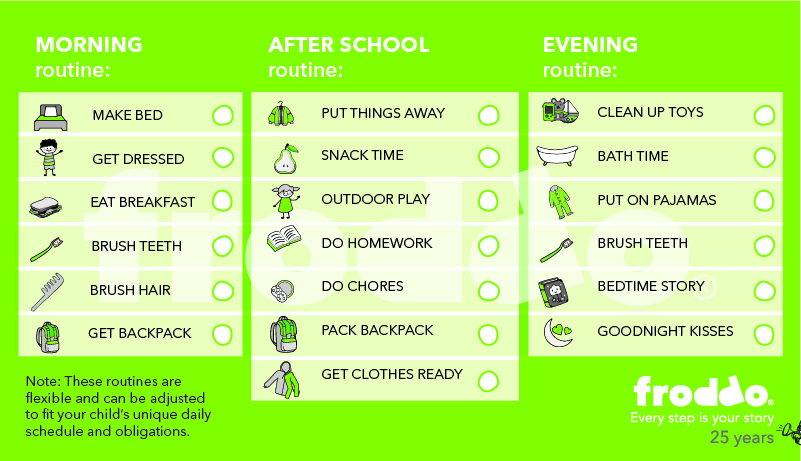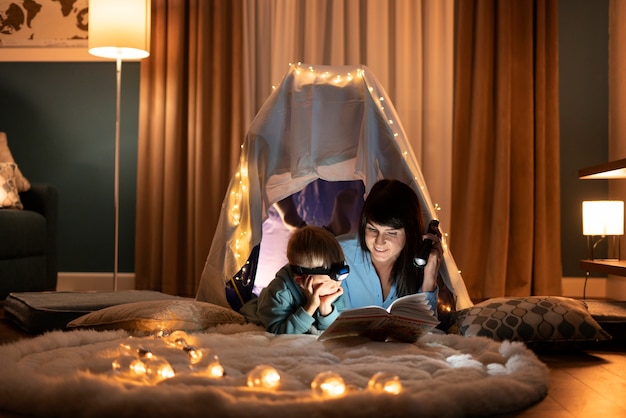Posted on: 25.11.2024.
Stress-Free Routines to Help Kids Thrive Throughout the Day

Mornings and evenings often feel chaotic for families with school-age children. Between meal preparation, checking homework, and getting ready for bed, it's easy to feel the pressure and lose control over the pace of the day.
With a little planning and consistency, parents can create routines that not only help kids stay organized and calm but also promote their emotional and physical well-being. A smoother flow can lead to a more productive school day and a peaceful end to the day.
Morning routines: setting the right tone for the day
A well-organized morning routine is essential to give your child the mental and physical energy they need to learn and thrive. To make mornings more manageable, it helps to break down tasks and set up a consistent structure that works for your household.
Prepare the night before
One of the easiest ways to reduce morning stress is to do as much preparation as possible the night before. Encourage your child to lay out their clothes for the next day, pack their school backpack, and even decide on breakfast options before going to bed. This eliminates last-minute decisions and keeps mornings from becoming a mad dash to find missing shoes or a forgotten homework assignment.

Also, consider prepping lunchbox or snack bags in advance. Even small things, like filling water bottles, can make a big difference in creating a smooth start to the day.
If your child tends to be forgetful in the morning, you can establish a designated "launch pad" area by the door — a spot where all their school essentials like shoes, backpacks, and jackets are ready to grab before heading out.
A consistent nighttime routine that includes these preparations also gives your child extra time to relax before bed, helping them sleep more soundly and wake up feeling rested.
Create a predictable morning routine
Children thrive on predictability, so having a consistent morning routine can greatly reduce stress. Create a step-by-step routine that includes everything from waking up to brushing teeth, having breakfast, and getting dressed.
For younger kids, a visual schedule can be helpful — consider a simple chart with images showing each task in order. This turns the routine into something your child can follow independently, making mornings more empowering and less chaotic.

Older children can use a checklist they can physically mark off as they complete each task. This helps them stay on track and builds good habits. The more structure and predictability you add to the morning, the fewer surprises there will be, which lowers stress for both kids and parents.
Start the day with positivity
How your child feels emotionally when they head out the door can shape their entire school day. To create a positive start, take a few moments to connect with your child in the morning.
Simple gestures like offering a word of encouragement, practicing a quick gratitude exercise, or sharing a brief conversation about something they’re excited about can make a big difference.

Children often reflect the emotions of those around them, so maintaining a calm and positive attitude can help set the tone for their mood. Additionally, avoiding rushed or frantic behavior can minimize unnecessary stress in the morning routine.
Prepare nourishing breakfast
A healthy breakfast fuels both body and mind, setting your child up for a productive day of learning. Opt for breakfasts that provide a balance of protein, healthy fats, and whole grains to keep your child feeling full and energized. If your mornings are especially tight on time, consider quick options like overnight oats, yogurt with fruit, or pre-made breakfast sandwiches.
To make mornings smoother, prepare simple grab-and-go breakfast items over the weekend, such as muffins, energy bars, or smoothie packs that can be quickly blended. This way, you have a stock of nutritious options ready, even when time is short.
Involving your child in choosing their favorite healthy foods can also boost their enthusiasm for eating a good breakfast, and make it feel more personal and exciting.
After-school transition: making afternoons relaxing and productive
Creating a consistent after-school routine helps kids decompress while staying productive, setting the stage for a stress-free evening. It’s about balancing relaxation with the responsibilities of homework, chores, and family time.
Establish a smooth after-school routine
When your child comes home from school, you should provide some decompression time before they jump into homework or chores. The shift from a structured school environment to the demands of home life can feel overwhelming for them.
Allowing your child 20 to 30 minutes of downtime helps them recharge. They can use this time to read, listen to music, or enjoy a healthy snack to relax and refuel.

Physical activity is another excellent way for kids to release pent-up energy after sitting in class all day. Whether they take a quick trip to the park, go for a bike ride, or play outside for a few minutes, movement can relieve stress and improve focus when it’s time to return to their responsibilities.
Make homework time stress-free
After your child has had some time to relax, set a clear time for homework. Knowing when and where to do homework helps create structure and removes any confusion about when to focus. Pick a quiet, comfortable spot without distractions so your child can work well on their assignments.
Some children may resist homework, especially after a long school day. In this case, use a timer to help. For example, set a timer for 20–30 minutes of focused work, followed by a short break. The method can prevent burnout and keep your child motivated. You can also introduce a small reward system, where completing homework efficiently earns extra free time or a favorite activity.

Remember that every child is different. While some may prefer tackling homework immediately after school, others might benefit from waiting until the evening. Stay flexible in finding what works best for your child, but try to maintain a routine once you discover the ideal time.
Set healthy limits for screen time
Technology plays a big role in children's lives today, but finding a healthy balance between screen time and other activities is important. Set boundaries to ensure they prioritize homework, physical play, and family time over screen use. Create clear rules, such as requiring them to finish homework before using screens or setting a specific daily limit.

Encouraging educational or creative screen activities can also make screen time more productive. Whether watching an educational documentary or using learning apps, balancing screen time helps maintain a healthy after-school routine.
Evening routines: wind down for a restful night
Evening routines help children transition smoothly from the day's activities to a peaceful, restful night. Establish calming habits at the end of the day to help kids relax and ensure they're ready to tackle the next day with energy and focus. Let's explore ways to make evenings smooth and stress-free.
Create a relaxing pre-bedtime routine
To help your child wind down, start by establishing a relaxing pre-bedtime routine that signals it’s time to slow down. Activities like reading a book, taking a warm bath, or listening to soothing music can help create a calming atmosphere. Avoid stimulating activities such as screen time or vigorous play, as these can make it harder for your child to settle down.

You can also dim the lights and lower the noise in your home to create a peaceful environment. A consistent routine will train your child’s body to recognize when it's time for bed, making the transition to sleep much smoother.
Stick to a consistent bedtime
Having a regular bedtime is essential for promoting good sleep habits. Choose a bedtime that allows your child to get the recommended amount of sleep for their age group, ensuring they wake up refreshed and ready for the day ahead. Keep the bedtime consistent, even on weekends, to help regulate your child’s internal clock.
Giving your child a gentle reminder 15 to 30 minutes before bedtime can help them mentally prepare for sleep, making the routine easier to follow without resistance. This predictability reduces stress and helps your child develop a healthy relationship with sleep.
Encourage calm reflections
As part of the evening routine, encourage your child to reflect on their day positively. This can include talking about something they’re grateful for, writing in a journal, or sharing highlights with the family.
These calming reflections help your child process their day and go to bed with a peaceful mind, contributing to a restful night’s sleep.
Tips for staying consistent
Creating routines is only half the battle—staying consistent makes them stick. Follow these tips to help you and your child maintain new stress-free routines.
- Start small by making simple changes, like setting a regular bedtime or laying out clothes the night before. Gradually introduce new habits to avoid overwhelming yourself or your child. Add more elements to your routine as you get comfortable with each step.
- Stay flexible when needed. Don’t worry if things don’t go perfectly every day. Focus on building a structure that works most of the time. If something goes off track, adjust and move forward the next day.
- Make it fun by including activities your kids enjoy. Let them choose their favorite breakfast, enjoy a special wind-down story at night, or use stickers to mark tasks they complete on a visual schedule. When routines are enjoyable, your kids are likelier to stick with them.
- Set a positive example by following your routines and staying organized. Show them how planning and staying on schedule helps everyone in the family feel more calm and in control.
Remember, consistency takes time, so be patient and celebrate small wins along the way.
Embrace the power of routine
Creating stress-free routines for your child’s mornings, afternoons, and evenings not only boosts their well-being but also encourages independence. By preparing ahead, balancing relaxation with responsibilities, and staying consistent, you help your child feel confident and capable of handling each day.
Start small, remain flexible, and add an element of fun. Over time, these routines will become second nature, giving your child a sense of calm, independence, and a successful school year.
